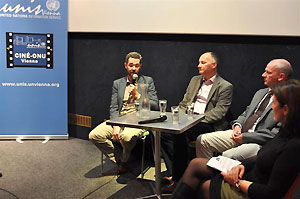
High-level nuclear waste is the inevitable end result of nuclear energy production. How to manage radioactive waste now and in the future was the topic of the sixth Ciné-ONU Vienna screening on 22 October 2012 showing the documentary "Into Eternity" by Michael Madsen.
"Into Eternity" is a film about the "Onkalo" project, Finland's approach to solve its nuclear waste problem by carving a vast, 5km-deep bunker out of solid rock to bury nuclear waste and thus keep it away from civilization for at least the next 100,000 years - the time high level nuclear waste remains hazardous to all living organisms.
The film puts a focus on the problem of our relationship with the future. It discusses the issue of nuclear waste from a philosophical / ethical point of view and questions Onkalo's intended eternal existence, addressing an audience in the remote future.
The panel discussion following the film was moderated by Irene Hoeglinger-Neiva, Public Information Officer at United Nations Information Service (UNIS) Vienna and featured the film director Michael Madsen, the Head of the Waste and Environmental Safety Section of the Department of Nuclear Safety and Security of the International Atomic Energy Agency (IAEA) Magnus Vesterlind and the Secretary of theUnited Nations Scientific Committee on the Effects of Atomic Radiation (UNSCEAR) Malcolm Crick.
In the discussion, Michael Madsen emphasized that what interested him mostly was the time issue: "For the first time in human history we have produced something that has consequences for 100,000 years." Magnus Vesterlind explained that no country has yet received a licence for the disposal of their nuclear waste and that obtaining a licence depends on the legal system of the respective country. In the case of Sweden it is up to the government to award such a licence, in Finland the Parliament needs to ratify the decision first. Malcom Crick mentioned the fact that we are constantly surrounded by natural-occuring radiation or even deliberate radiation such as x-rays, and that it takes very high levels of radiation to actually detect a slightly increased cancer rate in a certain region.
Critical voices in the audience also pointed out that the public figure of 250,000 tons of nuclear waste worldwide only constitutes the civilian use of nuclear waste, whereas the real danger emanates from the military nuclear waste which is about ten times higher.
All speakers agreed that the film was very moving through its emotional components, and successfully engaged people on the subject of nuclear waste. Public discussion should be further stimulated.
For further information visit the Ciné-ONU page.